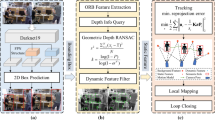Abstract
Track initiation for dim small moving target particularly in a heavy clutter environment is a theoretical and technological challenge for diverse tracking systems. The different spatial-temporal characteristics presenting in sequence scans are utilized to recognize target and initialize track in this paper. In spatial domain, the small target mapped in the image is a uniform gray spot other than pixel-sized object with high congregated degree, whereas, the false alarm is independent, irrelative and lower congregated degree. In temporal domain, the target’s trajectory projected on image sequence is continuous for the continuity of target motion and will appear in the neighborhood at consecutive instants with the maximum probability, on the contrary, the false alarm is disorderly, and occurs in the neighborhood at consecutive instants is impossible. Based on the spatial-temporal characteristics mentioned above, a track initiation algorithm for dim small moving target based on spatial-temporal hypothesis testing, which consists of neighborhood clustering and trajectory continuity, is derived and analyzed in detail. The theory analysis and experimental results show that this method could effectively initialize the track for dim small moving target in heavy clutter environment.









Similar content being viewed by others
References
Z. Hu, H. Leung, and M. Blanchette, Statistical performance analysis of track initiation techniques. IEEE Trans. Signal Process 45(2), 445–456 (1997).
F. Zhang, C. Li, and L. Shi, Detecting and tracking dim moving point target in IR image sequence. Infrared Phys. Technol 46, 323–328 (2005).
D. Liu, J. Zhang, and W. Dong, Temporal profile based small moving target detection in infrared image sequence. Int. J. Infrared Millim. Waves 28(5), 373–381 (2007).
R.-J. Liou, R. Mahmood, and Azimi-sadjadi, Dim target detection using high order correlation method. IEEE Trans. Aerosp. Electron. Syst. 29(3), 841–856 (1993).
S. Buzzi, M. Lops, and L. Venturino, Track-before-detect procedures for early detection of moving target from airborne radars. IEEE Trans. Aerosp. Electron. Syst. 41(3), 937–954 (2005).
S. Puranik, and J. Tugnait, Tracking of multiple maneuvering targets using multiscan JPDA and IMM filtering. IEEE Trans. Aerosp. Electron. Syst 43(1), 23–35 (2007).
B. D. Carlson, E. D. Evans, and S. L. Wilson, “Search radar detection and track with the hough transform, Part I: System concept. IEEE Trans. Aerosp. Electron. Syst. 30(1), 102–108 (1994).
H. Chen, Y. Bar-shalom, K. R. Pattipati, and T. Kirubarajan, MDL approach for multiple low observable track initiation. IEEE Trans. Aerosp. Electron. Syst 39(3), 862–882 (2003).
L. A. Johnston, and V. Krishnamurthy, Performance analysis of a dynamic programming track before detect algorithm. IEEE Trans. Aerosp. Electron. Syst 38(1), 228–242 (2002).
S. S. Blackman, Multiple hypothesis tracking for multiple target tracking. IEEE Aerosp. Electron. Syst. Mag 19(1, Part 2), 5–18 (2004).
I. S. Reed, R. M. Gagliardi, and L. B Stotts, Optical moving target detection with 3-D matched filtering. IEEE Trans. Aerosp. Electron. Syst 24(4), 327–336 (1998).
M. Li, T. Zhang, W. Yang, and X. Sun, “Moving weak point target detection and estimation with three-dimensional double directional filter in IR cluttered background. Opt. Eng 44(10), 1–4 (2005).
S. Matteo, L. Pierfrancesco, and F. Alfonso. A modified M/N logic for track initiation of low observable targets using amplitude information. International Radar Symposium (Krakow, Poland, 2006), pp. 1–4.
Acknowledgement
This work was partially supported by Chinese Education Doctor Fund under Grant No. 20070611013, and Chongqing Nature and Science Fund under Grants No. CSTC2006BB2161.
Author information
Authors and Affiliations
Corresponding author
Rights and permissions
About this article
Cite this article
Li, Z., Qi, L., Li, W. et al. Track Initiation for Dim Small Moving Infrared Target Based on Spatial-Temporal Hypothesis Testing. J Infrared Milli Terahz Waves 30, 513–525 (2009). https://doi.org/10.1007/s10762-008-9459-1
Received:
Accepted:
Published:
Issue Date:
DOI: https://doi.org/10.1007/s10762-008-9459-1




